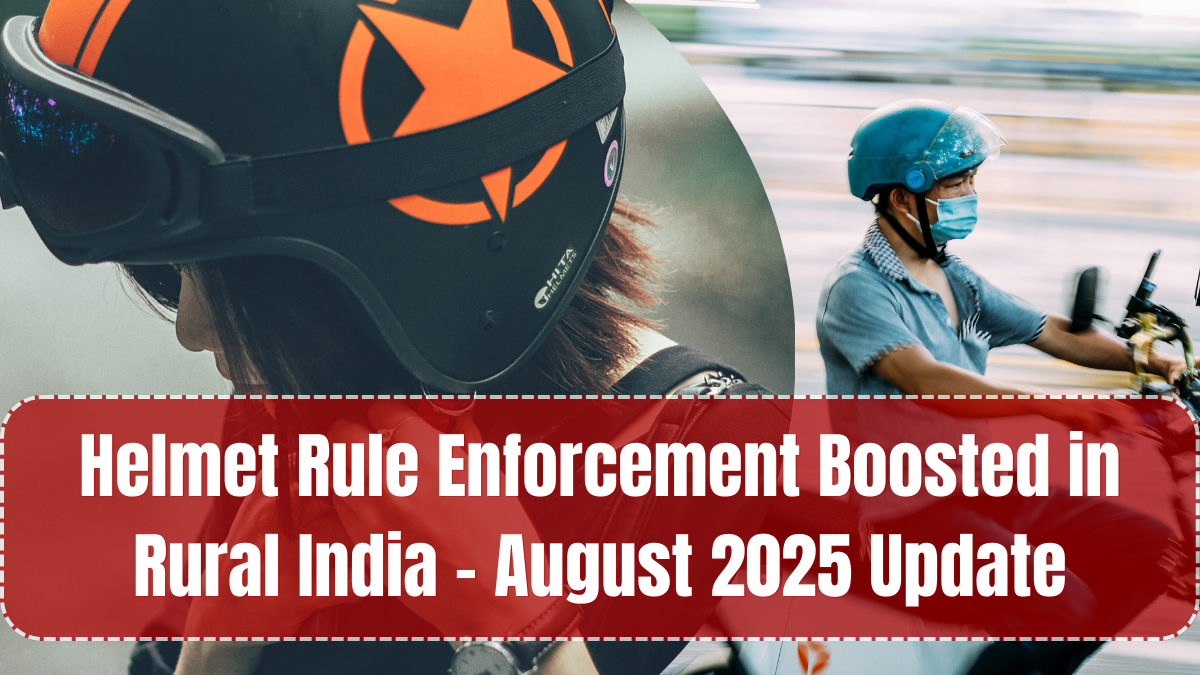The two-wheeler helmet rule update implemented in August 2025 has introduced stricter enforcement in rural and tier-2 regions of India, marking a serious shift in road safety priorities. While helmet laws were long enforced in urban cities, non-compliance remained high in smaller towns and villages. Now, under new government directives, all motorcyclists—including pillion riders—must wear helmets, with heavy penalties for violations.
This update is part of a nationwide safety overhaul by the Ministry of Road Transport and Highways (MoRTH) in coordination with local police forces and state transport departments.

Key Changes in the Helmet Rule for 2025
As part of the two-wheeler helmet rule update, both new and existing riders must adhere to the following rules strictly, regardless of their region or road type:
Updated helmet rules as of August 2025:
-
Mandatory helmet use for both rider and pillion in all districts
-
Fines increased to ₹2,000 per violation (previously ₹500–₹1,000)
-
Immediate seizure of license for repeated offenses
-
Mandatory use of BIS-certified helmets
-
Helmet use required even for short-distance commutes in villages
The stricter two-wheeler rules apply to both private and commercial bike users, including delivery agents and school staff transporting children on motorcycles.
Areas of Focus: Tier-2 and Tier-3 Cities
The helmet rule was traditionally under-enforced in semi-urban and rural regions. But in 2025, enforcement drives have intensified across India’s tier-2 cities like Bhiwadi, Guntur, Ranchi, and tier-3 towns like Azamgarh, Dharwad, and Chikmagalur.
Focus regions in 2025 include:
-
Northern India: Haryana, Punjab, and UP rural zones
-
Central India: Chhattisgarh and MP outer districts
-
Southern India: Tamil Nadu, Andhra Pradesh, and Karnataka villages
-
Western India: Gujarat and Rajasthan interiors
Traffic checkpoints have increased in these areas with added surveillance and mobile enforcement vans to ensure 24×7 compliance.
Why This Update Matters for Road Safety
The two-wheeler helmet rule update was driven by alarming statistics: over 70% of motorcycle accident deaths in India occur in rural areas where helmets are either not worn or improperly used. The rule is expected to reduce fatalities by ensuring proper head protection.
Key safety impacts of this rule:
-
Reduction in road deaths due to head injuries
-
Improved discipline among rural youth and teens riding bikes
-
Encouragement of safety-first mindset in underserved areas
-
Better enforcement visibility builds public trust
-
More responsible commercial riders in delivery and logistics sectors
The new rules empower traffic police and community volunteers to educate and penalize simultaneously.
Awareness Campaigns and Government Support
To ensure smooth implementation of the two-wheeler helmet rule update, awareness drives are being run alongside enforcement. Local governments have launched helmet distribution campaigns in schools, workplaces, and village markets to encourage compliance.
Support initiatives include:
-
Free helmet distribution to female pillion riders
-
Safety talks and demos in government schools
-
Posters and banners in local languages explaining two-wheeler rules
-
Training Panchayat leaders to conduct awareness rallies
-
Radio and mobile alert campaigns for farmers and laborers
The government’s goal is not only to penalize but also to educate and change rural India’s perception of road safety.
FAQs
What is the two-wheeler helmet rule update in 2025?
The two-wheeler helmet rule update requires both riders and pillion passengers to wear certified helmets, with strict penalties for violations across India, including rural zones.
Are helmets mandatory in villages now?
Yes, under the 2025 update, helmet use is compulsory even on rural roads and within villages, regardless of the distance traveled.
What is the fine for not wearing a helmet in rural India?
Fines have been increased to ₹2,000, and repeat violations can lead to license suspension under the updated two-wheeler rules.
Are there any exceptions to this rule?
No, the updated helmet rules apply to all two-wheeler users, with no exemptions for region, gender, or travel purpose.
How is the government ensuring compliance?
Police checkpoints, mobile enforcement vans, and awareness programs have been launched in tier-2 and tier-3 regions to monitor and enforce helmet usage.
Click here to know more.
